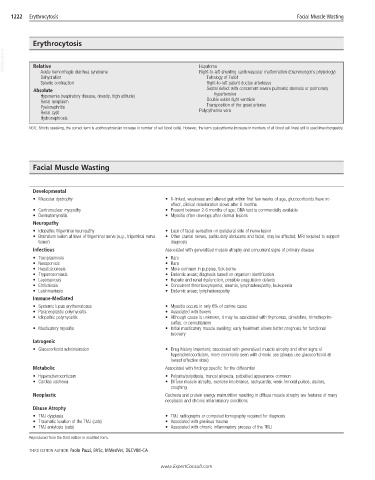Page 2465 - Cote clinical veterinary advisor dogs and cats 4th
P. 2465
1222 Erythrocytosis Facial Muscle Wasting
Erythrocytosis
VetBooks.ir Relative Hepatoma
Acute hemorrhagic diarrhea syndrome
Dehydration Right-to-left shunting cardiovascular malformation (Eisenmenger’s physiology)
Tetralogy of Fallot
Splenic contraction Right-to-left patent ductus arteriosus
Absolute Septal defect with concurrent severe pulmonic stenosis or pulmonary
Hypoxemia (respiratory disease, obesity, high altitude) hypertension
Renal neoplasm Double outlet right ventricle
Pyelonephritis Transposition of the great arteries
Renal cyst Polycythemia vera
Hydronephrosis
NOTE: Strictly speaking, the correct term is erythrocytosis (an increase in number of red blood cells). However, the term polycythemia (increase in numbers of all blood cell lines) still is used interchangeably.
Facial Muscle Wasting
Developmental
• Muscular dystrophy • X-linked, weakness and altered gait within first few weeks of age, glucocorticoids have no
effect, clinical deterioration slows after 6 months
• Centronuclear myopathy • Present between 2-6 months of age; DNA test is commercially available
• Dermatomyositis • Myositis often develops after dermal lesions
Neuropathy
• Idiopathic trigeminal neuropathy • Lack of facial sensation on ipsilateral side of nerve lesion
• Brainstem lesion at level of trigeminal nerve (e.g., trigeminal nerve • Other cranial nerves, particularly abducens and facial, may be affected; MRI required to support
tumor) diagnosis
Infectious Associated with generalized muscle atrophy and concurrent signs of primary disease
• Toxoplasmosis • Rare
• Neosporosis • Rare
• Hepatozoonosis • More common in puppies, tick-borne
• Trypanosomiasis • Endemic areas; diagnosis based on organism identification
• Leptospirosis • Hepatic and renal dysfunction, possible coagulation defects
• Ehrlichiosis • Concurrent thrombocytopenia, anemia, lymphadenopathy, leukopenia
• Leishmaniasis • Endemic areas; lymphadenopathy
Immune-Mediated
• Systemic lupus erythematosus • Myositis occurs in only 6% of canine cases
• Paraneoplastic polymyositis • Associated with boxers
• Idiopathic polymyositis • Although cause is unknown, it may be associated with thymomas, cimetidine, trimethoprim-
sulfas, or penicillamine
• Masticatory myositis • Initial masticatory muscle swelling; early treatment allows better prognosis for functional
recovery
Iatrogenic
• Glucocorticoid administration • Drug history important; associated with generalized muscle atrophy and other signs of
hyperadrenocorticism, more commonly seen with chronic use (always use glucocorticoid at
lowest effective dose)
Metabolic Associated with findings specific for the differential
• Hyperadrenocorticism • Polyuria/polydipsia, truncal alopecia, potbellied appearance common
• Cardiac cachexia • Diffuse muscle atrophy, exercise intolerance, tachycardia, weak femoral pulses, ascites,
coughing
Neoplastic Cachexia and protein energy malnutrition resulting in diffuse muscle atrophy are features of many
neoplastic and chronic inflammatory conditions
Disuse Atrophy
• TMJ dysplasia • TMJ radiographs or computed tomography required for diagnosis
• Traumatic luxation of the TMJ (cats) • Associated with previous trauma
• TMJ ankylosis (cats) • Associated with chronic inflammatory process of the TMJ
Reproduced from the third edition in modified form.
THIRD EDITION AUTHOR: Paolo Pazzi, BVSc, MMedVet, DECVIM-CA
.ExpertConsult.com
www.ExpertConsult.com
www

